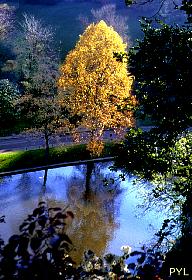Tulup tree, Liriodendron tulipiferum
 tree of the family of the Magnolia, (Magnoliaceae). tree of the family of the Magnolia, (Magnoliaceae).
 Etymology: named for the form of tulip of its flower (which is not comparable with the beautiful flower of Magnolia).
Etymology: named for the form of tulip of its flower (which is not comparable with the beautiful flower of Magnolia).
Origin: Virginia (USA), introduced to the Small Trianon, Versailles in 1771 (for Marie-Antoinette), but this nice tree was cut down by the storm of December 26th, 1999 (it was 228 years old).
Variety: there is a Tulip tree of China (its leaf differs slightly from that of the tulip tree of Virginia).
Habitat: The tulip tree of Virginia prefers soils well drained, in light texture, as slightly sour sandy or slimy soils.
The tulip tree of Virginia does not thrive in the very humid or very dry places.
Lifespan: 500 years.
Growth: rather quick. The wood of the tulip tree of Virginia is brittle. It can be broken by the strong winds.
Height: in the wild state, it can attain 50-60 metres tall, but in european parks, it does not exceed 30 m tall.
Bark smooth in its youth and cracked with age.
Characteristic deciduous leaf, with 4 tips (it looks like a tulip seen in face!). Nice yellow colour in autumn.
Flower (appearing after two decades) greenish and orange in the form of tulip, in May-June. The free carpels are transformed into winged type dry fruits samaras.
Uses: wood of yellow-greenish colour, used in sculpture. From its bark, one extracts a stimulant for heart. The Tulip tree was considered as an exotic tree to plant in european parks.
Where to see it in Paris? around the Palace Omnisport of Bercy. Nice species at the park Monceau and in the park of Buttes Chaumont.
|